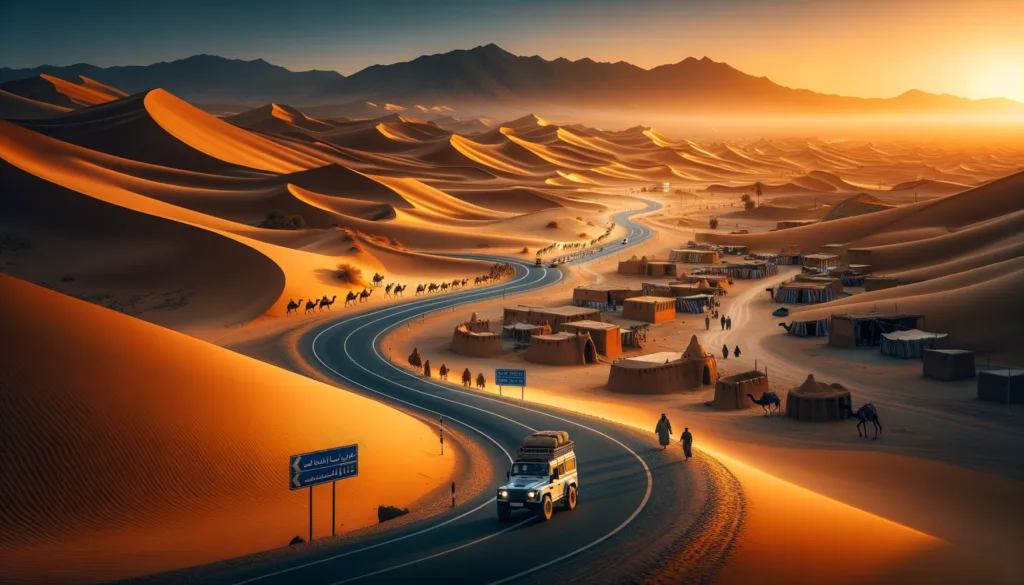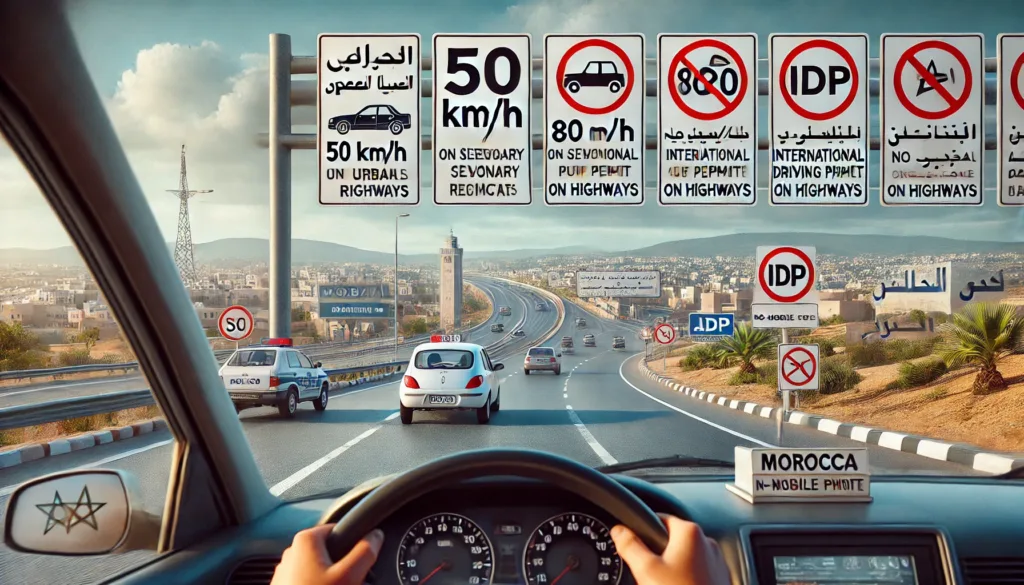
Embarking on a road trip from Marrakech to Merzouga is one of the most exhilarating ways to experience Morocco’s diverse landscapes. This self-drive adventure takes you from the bustling souks of Marrakech, through winding mountain roads, and into the vast golden dunes of the Sahara Desert. While the journey demands a bit of preparation and patience, it offers unmatched flexibility, allowing travelers to explore at their own pace and discover hidden gems along the way.
This guide aims to provide practical insights on driving between Marrakech and Merzouga, including detailed route information, road conditions, driving laws, and essential travel tips. Whether you’re a seasoned road tripper or embarking on your first Moroccan self-drive expedition, this guide will help ensure a smooth and enjoyable experience.
Driving Route and Duration
How Long Does It Take to Drive from Marrakech to Merzouga?
The drive from Marrakech to Merzouga covers approximately 560 kilometers (348 miles) and can take anywhere between 9 to 10 hours, depending on stops, road conditions, and traffic. While it is possible to complete the journey in a single day, many travelers prefer splitting it into two days to fully enjoy the stunning sights along the way.
The Recommended Route: Via the Tizi-n-Tichka Pass
The most common route follows the N9 and N10 highways, taking you through the iconic Tizi-n-Tichka pass, the highest major mountain pass in Morocco. This scenic route offers breathtaking views of the High Atlas Mountains, but its winding roads require careful navigation. After crossing the pass, travelers typically pass through Ouarzazate, a city known as the gateway to the desert, before continuing eastward toward Merzouga.
Alternative Routes
- Via Agdz and the Draâ Valley: This alternative route passes through the stunning palm groves of the Draâ Valley, offering a slightly longer yet scenic option.
- Through Boumalne Dades: Travelers looking for a more scenic and adventurous detour can take the route through the Dades Gorge and the Todra Gorge before reaching Merzouga.
What to Expect on the Journey
Much of the drive consists of well-paved roads, but certain sections, particularly in the mountains, contain sharp bends and sudden elevation changes. The journey transitions from lush green valleys in the Atlas Mountains to arid plateaus and eventually to the sandy expanse of the Sahara Desert near Merzouga.
Along the way, travelers can stop at charming Berber villages, visit famous kasbahs, and take in Morocco’s ever-changing landscapes. While the drive is long, the incredible scenery makes every kilometer worthwhile.
Road Conditions and Scenic Highlights
Changing Landscapes: From the Atlas to the Sahara
Driving from 3 to Merzouga takes you through some of Morocco’s most breathtaking landscapes, transitioning from bustling city roads to rugged mountain passes and finally to the golden dunes of the Sahara. The journey will take you through the High Atlas Mountains, where the air turns crisper, and the terrain becomes more dramatic.
Col du Tichka: Morocco’s Highest Road Pass
One of the most remarkable points along the route is Col du Tichka, the highest mountain pass in Morocco at 2,260 meters (7,415 feet) above sea level. The winding roads leading to this pass offer panoramic views of the Atlas Mountains, though drivers should proceed with caution due to occasional steep inclines and sharp bends.
Road Challenges and Infrastructure
While the road to Merzouga is generally well-paved, there are stretches with challenging conditions. Some key considerations include:
- Winding roads: Especially around the Atlas Mountains, curves can be tight, requiring careful driving.
- Narrow passages: In certain areas, roads are single-lane or shared with local traffic, including slow-moving trucks and livestock.
- Weather-impact risks: During winter, snow can occasionally block parts of the Tizi-n-Tichka route, while summer heatwaves might make desert driving particularly intense.
Noteworthy Stops and Attractions
The journey is as much about the stops as it is about the destination. Here are some recommended places to visit along the way:
- Aït Benhaddou: A UNESCO-listed ancient ksar with well-preserved mud-brick architecture.
- Ouarzazate: Known as the ‘Gateway to the Sahara,’ this city is famous for its film studios and desert landscapes.
- Dades and Todgha Gorges: Dramatic canyons with stunning red rock formations, ideal for short detours.
- Erfoud: The town where the terrain starts shifting from rocky desert to fine Sahara sand.
Driving Rules and Regulations

Driving Licenses and International Requirements
For tourists driving in Morocco, a valid driver’s license from your home country is generally sufficient. However, some rental agencies may require an International Driving Permit (IDP), so it’s best to check in advance. Drivers must be at least 21 years old, though some car rental companies impose a minimum age of 23 or 25.
Speed Limits and Road Safety
Morocco enforces strict speed limits, and violating them can result in hefty fines. Below is a general guide to speed regulations:
- Urban areas: 50 km/h (31 mph)
- Secondary roads: 80 km/h (50 mph)
- Highways: 120 km/h (75 mph)
Speed cameras are common, especially in rural areas, so staying within limits is strongly advised.
Essential Road Rules
Mobile Phone Usage
Using a mobile phone while driving is strictly prohibited unless you have a hands-free system. Fines for non-compliance can be significant.
Seat Belt Laws
Wearing a seat belt is mandatory for both drivers and passengers. Police checkpoints often check for compliance.
Alcohol Limits
Morocco has a zero-tolerance policy for drinking and driving. Any detectable amount of alcohol in a driver’s system can result in severe penalties.
Overtaking and Turning Restrictions
Overtaking on mountain roads requires utmost caution, and it is strictly prohibited in certain areas. Additionally, be mindful of roundabouts, as right-of-way rules can differ from those in Western countries.
By understanding and following these regulations, travelers can ensure a smooth and trouble-free driving experience on the route from Marrakech to Merzouga.
Car Rental, Preparations, and Travel Tips
Where and How to Rent a Car in Marrakech
Renting a car in Marrakech is relatively straightforward, with multiple international and local rental agencies available at the airport and in the city. Major providers such as Hertz, Europcar, and local agencies like AirCar offer a variety of vehicle options. Booking in advance is recommended, especially during peak tourist seasons.
Tips for Choosing the Right Rental Company
- Compare rental prices online to find the best deals and read customer reviews.
- Check if insurance is included and consider additional coverage for peace of mind.
- Opt for a 4×4 if you plan on exploring off-road areas near Merzouga.
- Confirm mileage limits and fuel policies in advance to avoid unexpected costs.
Vehicle Checks Before Starting Your Trip
Before setting off, thoroughly inspect the rental car. Take photos of any existing damages and ensure that necessary documents, such as insurance papers and registration, are provided.
Key Aspects to Check
- Brakes, tires, and headlights
- Fuel level and type of fuel required
- Spare tire, jack, and necessary tools
- Navigation system (or ensure GPS maps are downloaded)
Route Planning and Accommodation
While the drive from Marrakech to Merzouga can be completed in a day, considering an overnight stop along the way can make the journey more enjoyable. Popular options for a mid-way break include Aït Benhaddou or Ouarzazate.
Navigation Tips
- Use offline maps (Google Maps or Maps.me) in case mobile signals are weak.
- Plan fuel stops ahead, as gas stations become scarce after Errachidia.
- Be prepared for limited road signs in rural areas.
- Start early to avoid driving at night, as road lighting is minimal.
Cultural and Safety Tips for Driving in Morocco
Understanding Moroccan road etiquette and driving customs can contribute to a smoother trip.
Important Considerations
- Expect unexpected pedestrian crossings, especially in towns and villages.
- Locals may sometimes disregard lane discipline; drive cautiously.
- Be mindful of police checkpoints—carry necessary identification at all times.
- Avoid driving in sand dunes unless experienced and properly equipped.
Conclusion
Driving from Marrakech to Merzouga is not just about reaching the Sahara—it’s about the journey itself. The route takes you through diverse landscapes, remote villages, and breathtaking viewpoints, offering an unforgettable adventure.
With thorough preparation, awareness of road conditions, and respect for local driving customs, self-driving allows an immersive experience filled with freedom and flexibility. Whether you’re an experienced traveler or a first-time visitor to Morocco, this road trip promises stunning scenery, cultural enrichment, and a true taste of adventure.
So, plan wisely, drive carefully, and embrace the road ahead—it’s an experience you won’t regret!
FAQ: Driving from Marrakech to Merzouga
Is it possible to drive from Marrakech to Merzouga?
Yes, you can drive from Marrakech to Merzouga. The journey takes approximately 9-10 hours, passing through the scenic High Atlas Mountains via the Tizi-n-Tichka pass.
What is the condition of the roads?
The roads from Marrakech to Merzouga are generally well-maintained but can be narrow and winding, especially through the mountains. However, they offer stunning views and connect travelers to key attractions such as Ait Benhaddou and the Dades Valley.
Do I need an International Driving Permit (IDP) to drive in Morocco?
No, most international tourists can drive in Morocco using their home country’s driving license without requiring an International Driving Permit, as long as they are in the country legally as tourists.
What are the speed limits in Morocco?
The speed limits in Morocco are:
– 60 km/h in urban areas
– 100 km/h on secondary roads
– 120 km/h on highways
What are the key driving rules to follow?
Key driving rules in Morocco include:
– No turning right on a red light
– Using a hands-free kit for mobile phones
– Wearing seat belts at all times
– Adhering to the legal blood alcohol limit of 0.2 g/l
Where can I rent a car in Marrakech?
You can rent a car at Marrakech Menara Airport or in the city center. Numerous car rental agencies are available, and it is advisable to choose a reputable company with positive reviews.
What are the advantages of driving myself to Merzouga?
Driving to Merzouga offers flexibility and freedom, allowing you to explore sites at your own pace, stop for photos, and visit attractions such as Todra Gorge and local Berber villages.
What tips should I consider before driving from Marrakech to Merzouga?
– Ensure you are comfortable with long drives and navigating mountain roads.
– Inspect your rental car before beginning your trip.
– Plan your stops and accommodations, especially during peak seasons.
– Familiarize yourself with Moroccan road signs and driving customs.